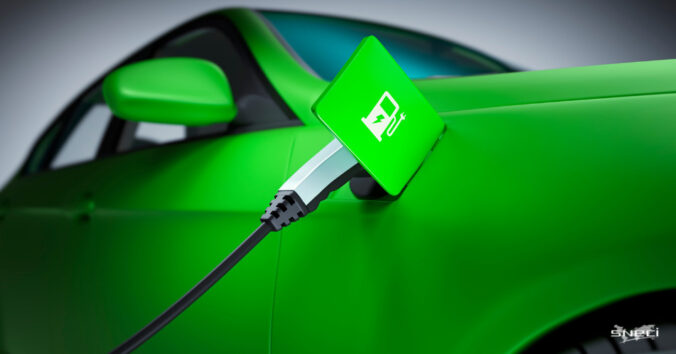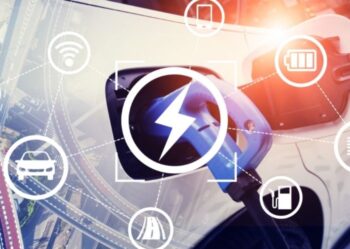Mobility: the many misconceptions about electric vehicles

The numerous subsidies granted to the French to acquire an electric vehicle (EV) that is less polluting and emits less greenhouse gas seem to be bearing fruit, since EV sales are constantly increasing.
Indeed, a good part of European countries have pushed the development of these electric vehicles, and have seen their sales double by 2020 and triple for plug-in hybrids. Electric vehicle sales now represent 2.5% of new vehicle sales worldwide. (Source: ACEA)
However, despite its strong emergence on the automotive market, the electric vehicle is still often mistrusted by the general public and raises many questions about performance, safety and investment.
Let’s untangle the true from the false with some preconceived ideas about the electric vehicle.
The electric vehicle is only used for short distance journeys
This is not true, in fact, today, the autonomy of electric vehicles varies on average between 350 and 400 km in real conditions of use. In fact, some models reach up to 600 km, or even more, as the vehicle manufacturer GAC offers with its Aion LX Plus model, an electric SUV capable of covering more than 1,000 km on a single charge.
This model shines through its innovations because beyond offering 1,000 km of autonomy, one of its strong points is that it has an ultra-fast charging capacity – eight minutes are enough to go from 0 to 80 percent, with a maximum power of 480 kW delivered by a terminal designed by GAC.
And to take it a step further, this model needs only 5 minutes to go from 30 to 80 percent charge, the Aion LX Plus has nothing to envy to gasoline or diesel powered models!
The electric vehicle is only interesting when driving in the city
So yes, at first sight, the electric vehicle allows to reduce noise pollution in the city and to limit CO2 emissions from engines in the most densely populated areas, especially during traffic jams or difficult periods.
But the electric vehicle is also very useful in urban areas, especially when public transport is lacking or less developed. Moreover, home recharging is much more accessible outside of cities, where it is more common to have a private home to install a suitable recharging infrastructure. And to go further, in addition to the electric vehicle, it is also the autonomous vehicle that tends to develop in urban areas to facilitate travel.
Electric vehicles do not meet everyone’s needs
With more than 200 models of electric vehicles or rechargeable hybrids available for almost all types of use, whether they are city vehicle, family vehicle, sedans, utility vehicles, etc., it would seem difficult not to find the model that suits your needs and your driving style.
It should not be forgotten that in France, almost all the thermal vehicle marketed have an electrified version.
Moreover, with the new regulations and the end of thermal vehicles, manufacturers have already announced their intention to switch to 100% electric vehicles by 2035.
An electric vehicle battery does not last long
Usually, it is recommended to change the battery of a combustion engine vehicle every 4 years. Moreover, it is necessary to change it as soon as the first signs of fatigue appear. Especially since a battery can wear out prematurely in certain cases:
- If it remains inactive, it will discharge to a point of no return.
- If it is overused.
- If it undergoes large temperature changes
- If the alternator breaks down
On the other hand, for an electric vehicle driving an average of 20,000 km per year, the battery can last between 10 and 15 years, which is well beyond the average life of a combustion engine vehicle.
Recharging an electric vehicle can take days
This is totally untrue, you can imagine if it took several days to recharge, the constraint would be unacceptable.
Fortunately, there are solutions adapted to the needs of each driver.
Depending on the vehicle and the charging station, high-powered recharging allows an electric vehicle to be recharged to 80% in less than 30 minutes.
For daily use at home or at work, there are also charging stations that allow you to recharge in a few hours. Then remember at the beginning of the article we talked about the 80% recharge in 8 minutes.
Don’t forget that soon, we will have a fast charging point every 100 kilometers of highway, so going far away with an electric vehicle will not be a problem anymore.
Buying an electric vehicle is far too expensive
Indeed, the cost of an electric vehicle versus a thermal vehicle can go from simple to double without forgetting that second-hand electric vehicles are still rare.
However, in order to bridge this gap, several acquisition aids exist and allow you to accumulate different amounts to finance the acquisition of low-polluting vehicles:
- Ecological bonus
- Conversion bonus
- Some communities (regions, municipalities, etc…)
Considering the increase in electricity prices, the electric vehicle appears to be less economical:
Globally a thermal vehicle can consume between 5L and 7L for 100km on average, with a rate of just over 1.50 euros per liter, the cost is at least 7.5 euros.
On the other hand, the cost of recharging an electric vehicle at home is about 3 euros per 100 km: this is about 2 to 3 times cheaper than filling up a gasoline or diesel vehicle.
In addition, the maintenance budget for electric vehicle is divided by 2 compared to thermal models.
And the little extra is that it is now possible to take advantage of free parking in certain cities when driving an electric vehicle, which is a considerable advantage.
All in all, the electric vehicle appears to be more economical.
Recharging in companies is not accessible to employees
Since the LOM law – the law on the orientation of mobility – companies will have to have charging stations on their sites and convert part of their vehicle fleets to electric, as part of their renewals.
Whether they are free or paid, open to visitors or reserved for employees (companies are free to decide this), employees will therefore have access to charging points at their workplaces.
Recharging at the workplace will therefore no longer be a problem
Fast charging is reserved for luxury vehicles
On average, it takes about eight minutes to fill up a thermal vehicle.
Of course, being in the early stages of electric vehicle deployment, charging at this point is indeed slower. However, with the high-powered charging stations that can now be found on all the country’s highway networks, recharging is much faster, reaching 80% in less than 30 minutes.
The advantage is that this type of charging is not exclusive to the most expensive and luxurious electric models.
Most new electric vehicles now tolerate 125 or 150 kW, including smaller, less expensive city vehciles. So you don’t have to buy a luxury sedan to get this benefit.
A broken battery cannot be repaired, it must be replaced
Most automotive manufacturers guarantee batteries for 8 years and 160,000 kilometers.
Moreover, modern batteries are very easy to repair. For example, Renault repairs thousands of batteries every year in its factories in Bordeaux, Lyon and Flins. It is all the more interesting that the repair is free for the owners of vehicles under warranty. And even without a warranty, the price of the repair, between €500 and €800, is much cheaper than replacing or changing the vehicle.
At the end of the vehicle’s life, batteries can either be used to store renewable energy or recycled to recover raw materials for new batteries.
In Europe, the law requires companies to recycle at least 50% of the weight of an electric vehicle battery. The automotive industry has already reached recycling rates of up to 95% of raw materials.
An electric battery pollutes a lot after its use
This is not true, in Europe, the law requires companies to recycle at least 50% of the weight of an electric vehicle battery. The automotive industry has already reached recycling rates of up to 95% of raw materials.
Recycled electric batteries are used as additional energy storage systems in industry or building equipment. After this second career, the battery is finally recycled. At Volkswagen, for example, at least 50 percent of the battery components can be reused.
At a time when RTE (French electricity provider) is asking the French to reduce their electricity consumption of electricity, it is clear that France will never have enough electricity to power the millions of electric vehicles
An often received idea that is totally false.
Let’s go back to the basics, namely that the energy efficiency of an electric vehicle is at least three times better than that of a thermal vehicle.
A quick calculation: on average, an electric vehicle consumes 2.5 MWh per year, or half the consumption of a household.
Thus, a fleet of one million electric vehicles represents 0.5% of the annual electricity consumption in France.
Therefore, 10 million electric vehicles correspond to 5.5% of the total consumption.
You can see that we are a long way from the predicted shortage, especially since at the same time other electrical uses by consumers are becoming increasingly efficient. Fridges, televisions, telephones and other heating systems are advancing in technology and consuming less and less electricity.
Thus, once the vehicle fleet has been massively converted to electric power, French electricity demand will be virtually stable. The development of renewable energies will also facilitate the transition, as will the famous vehicle-to-grid technology, which will eventually avoid problems related to peak consumption (when everyone wants to charge their vehicle at the same time). Well before that, smart charging innovations will also be very important to ensure that everything goes smoothly.
The electric vehicle pollutes
In Europe, the environmental impact of the electric vehicle is 2.5 times lower over its entire life cycle than that of a combustion engine vehicle.
This balance is continuously improving thanks to various solutions: reduction of the raw materials used in each battery, reuse and recycling of batteries, as well as the use of more renewable energies in French electricity production.
More nuclear power plants are needed to run more electric vehicles
It is important to know that recharging an electric vehicle at home represents the same consumption as a water heater.
Various solutions such as night charging and intelligent management of charging stations will make it possible to accommodate the 16 million electrified vehicles expected in 2035 without requiring additional electricity production capacity.
As you can see, the electric vehicle has many advantages not only in its use but also in its manufacture.
SNECI supports automotive battery manufacturers worldwide in the industrialization of their processes.
Our 10 subsidiaries and our 450 experts around the world allow us to intervene on the following points
- Market research
- Sourcing of your raw materials
- Audit of your critical suppliers
- Support for the launch of a production line, from design to manufacturing, testing and shipping
- Production transfers, from re-engineering and dismantling of equipment to production start-up on the new site, including transportation and product quality validation
- Plant support and industrial reorganization
- Management of critical suppliers during production start-up in terms of quality, cost and lead time
- Outsourcing of your support functions, internalization of expert resources
- Regular monitoring and reporting throughout the project phases
- …
You will have understood that industrialization has no secrets for SNECI. We have also assisted actors in France in the industrialization of batteries, or in the management of their critical suppliers, but also in China.
If you wish to be called back by our experts, contact Laura by email laura@sneci.com or send us a message on our website.






